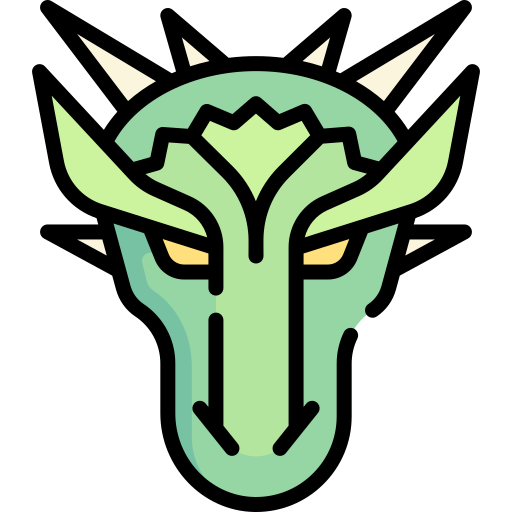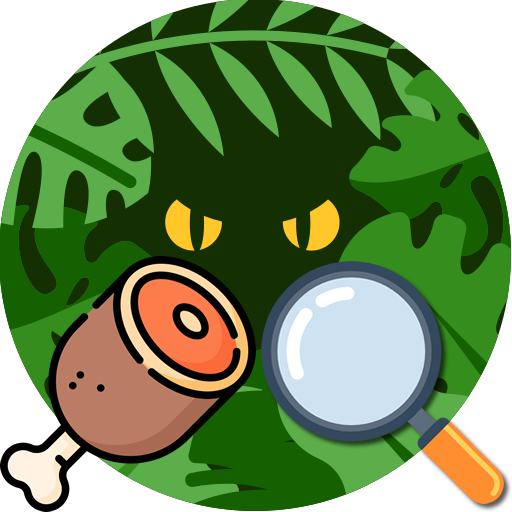 Abilities:
Abilities:-
Acid Breath Weapon (60) (12d8)
-
Slowing Breath Weapon (60)
-
Legendary Defenses
-
 Spellcasting |
Spellcasting |
-
 |
Hallucinatory Deceptions
Restoration, Adept
|
Hallucinatory Deceptions
Restoration, Adept
-
 |
Major Image
Stinking Cloud
|
Major Image
Stinking Cloud
-
 |
Charm Monster
Invisibility, Adept
Polymorph
Puzzling Confusion
Stone Shape
|
Charm Monster
Invisibility, Adept
Polymorph
Puzzling Confusion
Stone Shape
 Lair:
Lair:-
Copper Dragon Lair
 Monster Bits:
Monster Bits:-
1360 Animal Bone0.03 gp
-
2550 Animal Fat0.5 gp
-
5100 Animal Meat0.05 gp
-
1190 Dragon Blood10 gp
-
1700 Hard Skin0.1 gp
-
2040 Copper Dragon Scale25 gp
-
Dragon Egg5000 gp
Adorning its reptilian face, frills and horns frame the massive dragon, while manta-like wings span its length. Gazing at you with calm, curious eyes, a subtle smile plays upon its mouth. The sunlight accents the subdued yet beautiful shine of its copper scales. Moving with an alluring grace, it maintains a measured distance, studying you intently. Awe envelops you as the sheer magnitude of its size becomes fully apparent.
🧬 Biology & Physiology
Adult dragons are immense, reptilian beasts with rippling muscle, armored scales, and mighty wings capable of lifting their vast forms into the skies. Their size varies by species—typically ranging from 30 to 60 feet in length. Their scales are not just beautiful but nearly impenetrable, offering immense resistance to both physical strikes and magical forces.
🧠 Intelligence & Behavior
Dragons are not mere beasts—they are brilliant minds. Many possess wisdom and cunning that rivals the greatest mortal scholars and tacticians. Some can even wield arcane magic. Their behaviors differ by alignment and temperament: while some are fiercely territorial loners, others enjoy manipulating or even leading societies.
🏰 Lairs & Hoards
Dragons build their lairs in remote, formidable places—craggy mountains, ancient forests, underwater caverns. Within lies their legendary hoard: a glittering cache of gold, gemstones, magical relics, and treasures gathered over centuries. These hoards are not just wealth, but a reflection of a dragon’s pride, power, and history.
🔥 Breath Weapons
A dragon’s signature ability is its devastating breath weapon, unique to its type:
- 🔥 Fire (e.g., red dragons)
- ❄️ Ice (white dragons)
- ⚡ Lightning (blue dragons)
- ☠️ Poison (green dragons)
- 🧪 Acid (black dragons)
This power can level armies, melt stone, or scatter foes in a single exhalation.
✨ Magical Abilities
Beyond sheer physical dominance, many dragons are naturally magical. They may:
- Cast spells
- Shape-shift into other forms
- Cloak their lairs with illusions
- Control weather or natural elements
- These abilities often mirror their elemental alignment and make them even more unpredictable and dangerous.
📚 Cultural Impact
Dragons are woven deeply into the myths, religions, and folklore of countless civilizations. Some are worshipped as deities, others feared as cataclysmic monsters, and many seen as keepers of ancient secrets. Their presence often shapes entire cultures, influencing art, tradition, and legend.
🌿 Ecological Role
As apex predators, dragons dramatically shape their environments. Their mere presence shifts the behavior of other species, from prey migration patterns to predator hierarchies. Some dragons even forge symbiotic bonds, protecting smaller creatures in exchange for tribute or service.
⚖️ Alignment & Morality
A dragon’s moral alignment deeply influences its actions:
- Chromatic dragons (red, blue, green, black, white) → Typically evil
- Metallic dragons (gold, silver, bronze, brass, copper) → Generally good
This contrast defines whether they are villains to be vanquished or allies to be revered.
⏳ Lifespan & Aging
Dragons live for millennia. As they age, they grow in size, power, and intellect. The eldest—ancient or great wyrms—are beings of nearly divine might, with knowledge that spans epochs. However, their immense age also brings inflexibility and stubborn pride.
🌟 In Summary
Adult dragons are awe-inspiring forces of nature, balancing brute strength, profound intellect, and magical prowess. Whether as terrifying foes or mystic mentors, they offer endless possibilities for adventure, storytelling, and worldbuilding in any fantasy realm.
-
 Speed:
Speed:
-
 Walking Speed:
+40
Walking Speed:
+40
-
 Flying Speed:
+80
Flying Speed:
+80
 Special Senses:
Special Senses:-
 Nightsight: +120
Nightsight: +120
-
 Blindsight: +60
Blindsight: +60
 Immune to Status Effect:
Immune to Status Effect:-
 Frightened
Frightened
 Natural Armor:
Natural Armor:-
Natural Armor +90 gp
 Natural Weapon(s):
Natural Weapon(s):-
Bite (10) (2d10)
-
Claw (2d6)
-
Tail (15) (2d8)
 Extra Attack: +4
Extra Attack: +4
 Abilities:
Abilities:-
Wing Whirlwind
 Quick Abilities:
Quick Abilities:-
Legendary Detection
 Free Abilities:
Free Abilities:-
Frightful Presence
 Skill Tier 2:
Skill Tier 2:-
 Common Language Skill
Common Language Skill -
 Draconic Language Skill
Draconic Language Skill
 Skill Tier 8:
Skill Tier 8:-
 Bending Weapon Skill
Bending Weapon Skill -
 Empathy
Empathy -
 Frighten
Frighten -
 History
History -
 Inspection
Inspection -
 Magic
Magic -
 Natural Armor Skill
Natural Armor Skill -
 Natural Weapon Skill
Natural Weapon Skill
 Skill Tier 10:
Skill Tier 10:-
 Attention
Attention -
 Fortitude
Fortitude -
 Influence
Influence -
 Sneak
Sneak -
 Willpower
Willpower
😄 The Mischievous Copper Dragon
Copper dragons are the irrepressible jesters of the draconic world, weaving humor, riddles, and pranks into the fabric of their lives among the rugged hills and rocky uplands. Their gregarious and easygoing nature makes them beloved by those who share their love of wit, but beneath their playful exterior lies a fiercely covetous streak, turning them into formidable foes when their cherished hoards are at stake. These dragons are as much entertainers as they are guardians, their lairs echoing with laughter and the clink of treasured coins.
🦎 Striking and Playful Form
A copper dragon’s visage is a blend of cunning and charm, with prominent brow plates jutting over its keen eyes, flowing into long, segmented horns that curve back like the flourish of a quill. Its backswept cheek ridges and delicate jaw frills lend it a thoughtful, almost mischievous expression, as if it’s perpetually plotting its next jest. At birth, its scales are a ruddy brown with a faint metallic sheen, but as it matures, they transform into a vibrant, coppery hue that gleams like freshly minted coins. With age, a verdant patina creeps across its hide, giving older dragons a greenish tint reminiscent of weathered bronze. The pupils of ancient copper dragons fade, their eyes glowing like radiant turquoise orbs that sparkle with mirth and wisdom.
🎭 Incorrigible Pranksters
Copper dragons live for the joy of a well-timed prank or a clever riddle, delighting in outwitting friends and foes alike. They pepper conversations with jokes, puns, and enigmatic puzzles, testing the intellect and humor of those they meet. Their lairs are stages for elaborate hoaxes—false treasure rooms, illusory traps, or hidden passages that lead to comical dead ends—designed to amuse rather than harm. Yet, their playful nature has limits; they are quick to forgive those who take their jests in stride but grow prickly when their antics are met with scorn. A copper dragon’s laughter is infectious, but its temper, when roused, is as sharp as the acid it breathes.
💰 Covetous Collectors
Despite their jovial demeanor, copper dragons are fiercely possessive, guarding their hoards with a miser’s zeal. They covet coins, gemstones, and artifacts, particularly those crafted with artistry or historical significance, such as filigreed jewelry, etched goblets, or ancient medallions. Their hoards are meticulously organized, each item placed to catch the light or tell a story of acquisition, often tied to a clever ruse or hard-won bargain. Threatening a copper dragon’s treasure is a grave mistake—its playful facade gives way to a ruthless defender, wielding acid breath and agile claws to protect what is theirs. They are not above using their shapeshifting to recover stolen goods, often with a prank that leaves the thief humiliated.
🦋 Shapeshifting Tricksters
Copper dragons are adept shapeshifters, slipping into humanoid or animal forms to mingle with hillfolk, travelers, or wandering bards. They might appear as a cheeky peddler, a curious fox, or a wise hermit, using these guises to gather gossip, test strangers’ character, or orchestrate harmless mischief. Their love of interaction drives them to engage with communities, where they share stories and riddles, often leaving behind a trail of bemused smiles or puzzled frowns. These disguises also serve their covetous nature, allowing them to scout for treasures or spy on potential threats to their hoards without revealing their true power.
🏞️ Masters of the Highlands
Copper dragons thrive in the rolling hills and rocky uplands, where the air is crisp and the landscape offers endless hiding spots for their games. They are attuned to the rhythms of the earth, weaving their lairs into natural caves, abandoned mines, or cliffside hollows with breathtaking views. Their presence enlivens the land, encouraging wildflowers to bloom and streams to sparkle, as if the hills themselves share in their mirth. They are fiercely protective of their domains, driving off threats like green dragons or hill giants with a mix of acid breath and cunning traps, ensuring their playground remains undisturbed.
💎 Treasures of Wit and Craft
A copper dragon’s hoard is a dazzling reflection of its personality, brimming with items that spark joy or intrigue. They prize turquoise, malachite, and other stones with earthy hues, alongside finely wrought metalwork—engraved daggers, embossed shields, or musical instruments that hum with melody. They also collect curiosities tied to their pranks, such as a noble’s signet ring won in a riddle contest or a thief’s lockpicks left behind after a failed heist. These treasures are often hidden in multiple caches, concealed by illusions or buried in secret vaults, with the dragon’s flawless memory ensuring nothing is ever lost. Adventurers who stumble upon a copper dragon’s trove may find themselves invited to a game of wits to earn their prize—or outsmarted and sent away empty-handed.
🏰 A Copper Dragon’s Lair
Copper dragons craft their lairs in the heart of rugged highlands, choosing sites that blend natural beauty with strategic advantage—caverns tucked behind waterfalls, hollows carved into windswept cliffs, or ancient ruins reclaimed by moss and vines. These sanctuaries are as whimsical as their inhabitants, with chambers designed to confuse or delight. False walls, shifting floors, and harmless traps—like a chute that deposits intruders into a pile of soft sand—reflect the dragon’s love of fun. The air carries the faint tang of acid and the scent of wild herbs, while sunlight streams through natural skylights, illuminating treasures and casting playful shadows.
A legendary copper dragon’s magic infuses its lair with a lively energy, causing faint giggles to echo through the tunnels or breezes to carry the sound of distant laughter. The terrain shifts subtly to thwart intruders, with loose stones tripping the unwary or vines snagging careless feet. The dragon uses its lair’s quirks to its advantage, darting through hidden passages or perching on high ledges to lob riddles or acid at foes, all while grinning with impish glee.
🎉 Guardians of Glee
Copper dragons are the embodiment of merriment and mischief, their lives a tapestry of jokes, riddles, and hard-won treasures. They are not as noble as bronze dragons nor as talkative as brass dragons, but their blend of humor and tenacity makes them unforgettable. Their pranks and games foster camaraderie, but their covetous nature ensures they never part with their wealth lightly. To befriend a copper dragon is to gain a partner whose wit brightens the darkest days and whose loyalty is as enduring as the hills. To cross one is to face a trickster whose acid burns as fiercely as their laughter echoes, a reminder that even the jolliest dragon guards its heart—and hoard—with unyielding resolve.
-
 Speed:
Speed:
-
 Climbing Speed:
[speed_walking]
Climbing Speed:
[speed_walking]
 Damage Type Immunity:
Damage Type Immunity:-
 Acid
Acid
 Creature Type Monster Bits:
Creature Type Monster Bits:-
0.12 Copper Dragon Scale25 gp
Environment:
![]()
🛡️ The Exalted Metallic Dragons
Metallic dragons are the epitome of draconic nobility, their shimmering scales and virtuous hearts setting them apart from the malevolent chromatic dragons. These majestic beings embody wisdom, compassion, and a profound commitment to the greater good, weaving their influence into the tapestry of the world with grace and purpose.
🌟 Guardians of Harmony
Metallic dragons are radiant beacons of benevolence, viewing themselves as stewards of balance in a world teeming with diversity. They champion harmonious coexistence, recognizing the intrinsic value of every creature, from the humblest villager to the mightiest giant. Unlike their chromatic kin, who sow discord, metallic dragons strive to nurture peace and protect the delicate equilibrium of life. Their actions are guided by a deep-seated belief that all beings have a role in the grand design, and they intervene—sometimes subtly, sometimes with awe-inspiring might—to ensure this harmony endures.
📜 Curators of History
While metallic dragons share the draconic love of treasure, their hoards are not mere piles of wealth but meticulously curated archives of history and culture. Each item—be it an ancient coin, a hero’s blade, or a tome of forgotten lore—holds a story, preserved to enrich the world’s collective memory. They collect relics not for greed but to safeguard the past, ensuring that the triumphs, tragedies, and wisdom of bygone eras are never lost. Some metallic dragons also hoard dangerous artifacts, locking them away to prevent their misuse, their lairs serving as both museum and vault. This reverence for legacy makes them unparalleled repositories of knowledge, sought by scholars and adventurers alike.
⚖️ Protectors of the Greater Good
Metallic dragons are not swayed by avarice, but their attachment to their hoards is profound, rooted in their role as custodians. They part with treasures only when convinced that doing so serves a noble cause—such as thwarting a rising evil or aiding a worthy hero. Convincing a metallic dragon to relinquish an item is a test of diplomacy, requiring petitioners to appeal to the dragon’s sense of duty and align their goals with the greater good. These encounters often spark moral dilemmas, as adventurers must prove their intentions are pure, lest they face the dragon’s discerning judgment.
🦋 Solitary Shapeshifters
Among their most captivating traits, metallic dragons possess the ability to shapeshift into humanoids or beasts, blending seamlessly into the world’s myriad cultures. As a kindly merchant, a wandering bard, or a gentle forest creature, they immerse themselves in the lives of others, savoring local customs, cuisines, and stories. This practice not only sates their boundless curiosity but also deepens their understanding of the world they protect. Some metallic dragons spend decades in disguise, forging subtle connections with communities or observing the ebb and flow of civilizations. Their shapeshifting is both a tool for learning and a means of safeguarding their privacy, allowing them to act as unseen guardians or enigmatic allies.
🧬 Custodians of Ancient Memories
With lifespans stretching across millennia, metallic dragons possess memories as vast as the skies they soar. They recall every encounter, triumph, and betrayal with crystalline clarity, their perspectives shaped by centuries of interactions. Remarkably, they can identify bloodlines by scent, tracing lineage through generations to honor ancient debts or settle old grudges. A metallic dragon might greet a hero with warmth, recognizing the blood of a long-ago friend, or confront a villain with icy disdain, sensing the taint of an ancestor’s treachery. These connections create rich dynamics, turning encounters into moments of revelation where the past and present collide.
🌍 Pillars of Wisdom and Wonder
In a campaign, metallic dragons are more than creatures—they are catalysts for profound storytelling. Encounters with these guardians of goodness offer opportunities for moral quandaries, quests for ancient knowledge, or tests of diplomatic finesse. Whether players seek to earn a dragon’s favor, uncover the secrets of its hoard, or enlist its aid against a looming threat, metallic dragons bring depth and gravitas to any adventure. Their lairs, often hidden in majestic locales—cloud-wreathed peaks, coastal cliffs, or sunlit canyons—are stages for awe-inspiring moments, where the weight of history and the promise of heroism converge. To engage with a metallic dragon is to touch the soul of the world, forging legends that echo through the ages.
 Abilities:
Abilities:-
Change Shape
